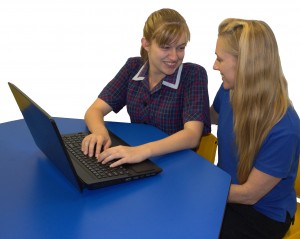
Here are some strategies for students with APD for teachers to consider and for parents to share with their child's teacher to set students up for success for the new school year. The classroom places the greatest demands on a child’s listening, hearing and comprehension abilities. It is therefore important to assess the classroom where a child with Auditory Processing Disorder (APD) is placed, and put in place strategies to support their hearing and listening abilities. This will then have a positive effect on their achievement with learning, language and literacy.
A child with APD would benefit from the following strategies:
Classroom acoustics: The acoustics (the noise level and the way sound travels within the classroom) is vital to consider when placing children with APD.
Consider the following criteria:
- Open plan classrooms: are a disadvantage to children with APD their noise levels are typically higher and more distractions are present.
- Location of classroom: classrooms situated near sports ovals or drama rooms are typically higher in noise level.
- Study areas: encourage classrooms to have ‘study areas’ which are quiet areas with barriers (fabric, or cushions) which enclose the area away from classroom noise.
The following strategies can be used by teachers to support students:
Instructions:
- Before giving an instruction, ensure you have the child’s attention first by getting their eye contact.
- Provide short/concise instructions, and tell the student the purpose of what they are listening for e.g. “Listen while I tell you how to get to the art room”
- Repeat the instruction without changing it from the first time. This allows them to process the parts they may have missed in the first instruction.
- Keep instructions within the child’s memory limits e.g. “Get your big maths book and pencils”
When speaking to your student:
- Use a slower rate of speech and more deliberate phrasing to help them segment the information.
- Provide information in ‘chunks’ rather than long strings e.g. wait until the child has their maths book out before you tell them what page to turn to.
- Use longer pauses than normal between sentences and phrases.
- Emphasize important words in a sentence.
- Allow your student more time to respond.
Preferential seating:
- The child with APD should be involved in the process of picking the seat with some guidance.
- They should be seated away from ambient noise e.g. fish tanks, computers, air-conditioners, doorways. Have them on a single desk rather than a double desk.
- Distance from the teacher should be 2- 2.5 meters, and in view of the teacher at all times, to use body gestures and facial expression to support understanding.
- This will also allow the teacher to see if the child is ‘on track’.
Group work:
This is likely to be difficult for children with APD as they are unable to tune in and out of sound with is relevant or irrelevant. They may also find it hard to separate the group members voice from other nearby groups. They find it difficult to follow which voice is talking and therefore, cannot give eye contact and miss out on information.
- Try to use smaller groups where possible 2-3 members.
- Allow them to go to a quiet area or another room away from other groups.
- Practice listening skills using listening games in groups e.g. chinese whispers, I went shopping….
Teach new vocabulary:
If possible, allow your student to learn the vocabulary of a new topic before it is introduced. This could be homework or done with a LAP worker, provide them with a list of the new words. The child would have already been exposed to these words and more familiar with them, which will ease the processing required.
Listening skills:
Efficient listening skills can be taught, and the students listening will improve with practice. It is easier to sustain attention and listen, if the child knows the vocabulary, so ensure they are familiar with the words you use. Use listening games, or ask the child to repeat back a phrase, as they improve make the phrase longer and practice listening skills.
Visual supports:
- Provide visual supports and back-up for information given orally:
- Written instructions rather than just spoken
- Checklists e.g. in front of their maths book
- Picture clues
- Lists of vocabulary
- Use dots/stars on a page to cue the child that there are a certain amount of items to remember
- Establish routines and have your student write down the days schedule
Class buddy
Pairing a student with APD with another class room member will provide them with support and reduce their dependence on the teacher for repeated instructions. This would also give the student a chance to watch what is happening and check their understanding with their classmate.
For more great, free ideas on language and literacy visit the downloads section of Our website. If you are concerned about your child's communication or literacy browse our website to see how Talking Matters can help! We also have a range of literacy resources including PLD resources and Reading doctor which are useful for both families and schools to help kids develop literacy.
Check our Pinterest page for loads more activities, information and ideas. Check the Talking Matters website for other useful resources. Like us on Facebook and follow us on Twitter so you don't miss out on what's happening.
Related Blog Posts
If you liked this post you may also like:
Preschool memory skills
Ready to Write with OT
3 language texts for school
Show and tell



